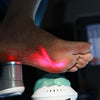Understanding Ankle Sprains

Ankle sprains develop when the ligaments that support the joint are stretched or torn beyond their normal range of motion. Ligaments are thick, fibrous bands that connect bones to each other and play an important role in joint stability. The lateral (outside) ligaments, which include the anterior talofibular, calcaneofibular, and posterior talofibular ligaments, are the most typically damaged in ankle sprains.
Causes of Ankle Sprains
1. Inversion Injury: An inversion injury, which happens when the foot rotates inward, stretching or tearing the outer ligaments, is the most common cause of ankle sprains. This can happen when running, jumping, or while walking on uneven surfaces.
2. Eversion Injury: This occurs when the foot slides outward, potentially hurting the inner (medial) ligaments.
3. High-Impact Activities: Sports involving rapid direction changes and jumping, such as basketball, soccer, or tennis, might increase the risk of ankle sprains.
4. Uneven ground: Walking or running on uneven surfaces, such as trekking on trails or stepping on rocks, increases the chance of an ankle twist.
5. Previous Injuries: A history of ankle sprains can weaken the ligaments and make the ankle more prone to sprains in the future.
Types of Ankle Sprains
Ankle sprains are categorized according to the severity of the ligament damage:
Grade I: The ligaments are strained but not torn in this minor sprain. Although there may be some slight pain and swelling, mobility is normally preserved.
Grade II: A moderate sprain is caused by partial ligament tearing, which causes moderate discomfort, edema, and some loss of joint stability.
Grade III: A severe sprain means that one or more ligaments have been completely torn. It causes considerable discomfort, edema, and a significant loss of joint stability.
Ankle Sprain Symptoms
Ankle sprains are commonly associated with the following symptoms:
1. Pain: Depending on the severity of the sprain, pain might range from minor to severe.
Swelling: Swelling is common within hours following an injury and can be severe.
Bruising: Because blood vessels rupture, bruising may form around the affected area.
4. Tenderness: The wounded area may be sensitive to touch.
5. Instability: The sensation of the ankle "giving way" or being unstable when walking or bearing weight.
6. Stiffness: Ankle joint rigidity and reduced range of motion.
Ankle Sprain Treatment Options
The degree of an ankle sprain determines the treatment. Following are some general guidelines:
1. RICE Protocol:
● Rest: Avoid placing weight on the hurt ankle.
● Ice: Apply ice to the affected area to minimize swelling and pain. Apply for 15-20 minutes every 1-2 hours, using a cloth or towel to protect the skin.
● Compression: To help decrease swelling, use a compression bandage or wrap.
● Elevation: Elevate the ankle above the level of the heart to reduce edema.
2. Pain Management: - OTC pain medications such as ibuprofen or acetaminophen can help manage pain and inflammation. Follow the dose directions and, if necessary, visit a healthcare provider.
3. Immobilization: A brace, splint, or cast may be required to immobilize the ankle to aid recovery in situations of moderate to severe sprains.
4. Physical Therapy: Physical therapy can help the injured ankle regain strength, flexibility, and stability.
5. Rest and Gradual Return to Activity: Rest is necessary for the ligaments to recover. Reintroduce weight-bearing and physical activities gradually under the supervision of a healthcare physician or physical therapist.
6. Surgery: Surgical intervention may be required in rare situations of significant ligament injury or repeated ankle sprains to repair or replace the damaged ligaments.
Ankle sprains can be painful and disruptive, but with proper care, most people can heal completely and regain their mobility. To reduce the risk of future sprains, seek immediate medical attention, and adhere to the indicated treatment plan. You may maintain an active and pain-free lifestyle by taking preventive efforts and being attentive to your ankle health.





